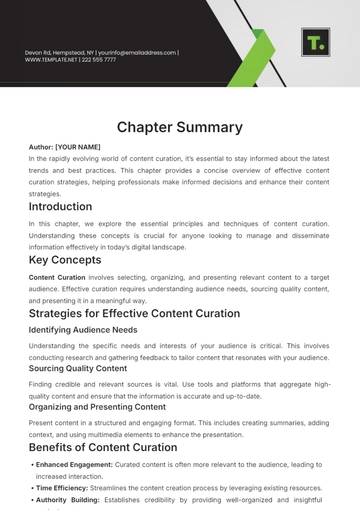Chapter
Introduction
This Printable Chapter is part of an educational resource designed to introduce students and professionals to the fundamentals of Digital Marketing Strategy. This chapter is designed to assist students and educators by offering practical examples, structured information, and valuable insights. Authored by [YOUR NAME], this material ensures learners can deepen their understanding of key concepts. All company information provided is for instructional purposes and may be customized to fit specific needs.
Understanding Digital Marketing Strategy
In this section, we will explore the basics of digital marketing strategy, focusing on the planning, execution, and measurement of online campaigns. The emphasis will be on practical applications, key marketing theories, and strategies that are essential for successful digital marketing efforts in the 2050s.
Key Concepts in Digital Marketing Strategy
Definition of Digital Marketing Strategy
A digital marketing strategy is a plan that outlines how businesses will use online platforms and tools to achieve marketing objectives. It involves setting goals, defining target audiences, selecting channels, and measuring performance to ensure the effectiveness of digital efforts.
Core Principles
The success of a digital marketing strategy relies on several core principles:
Goal-Oriented Planning: Setting specific, measurable, attainable, relevant, and time-bound (SMART) goals.
Audience Segmentation: Identifying and targeting specific demographics based on data and behavior.
Content Optimization: Ensuring content is tailored for each platform and audience to maximize engagement.
Applications in Marketing and Business
Digital marketing strategies are applied in numerous industries, from retail to healthcare. For example, in e-commerce, companies use search engine optimization (SEO) and pay-per-click (PPC) advertising to drive traffic to their websites, while healthcare providers might leverage social media to educate patients and promote services.
Case Study: Practical Implementation of Digital Marketing Strategy
Consider the following case study, which highlights the practical implementation of a digital marketing strategy in a real-world scenario. This example will provide learners with insights into how strategic planning and execution can drive business results.
Date | Event | Location | Participants | Outcome |
|---|
May 15, 2050 | Project Kickoff | Chicago, IL | Jonathan Brown, Evelyn Turner, Sarah Williams | Successful Launch |
June 20, 2050 | Mid-Project Review | New York, NY | Evelyn Turner, Samuel Johnson, Maria Lopez | Identified Challenges |
August 10, 2050 | Final Testing | San Francisco, CA | Sarah Williams, Jonathan Brown, David Taylor | All Systems Passed |
October 1, 2050 | Project Completion | Boston, MA | Evelyn Turner, Jonathan Brown, Samuel Johnson | Delivered on Schedule |
November 5, 2050 | Evaluation Meeting | Los Angeles, CA | Sarah Williams, Maria Lopez, David Taylor | Future Improvements |
In this case study, [YOUR COMPANY NAME] implemented a digital marketing strategy across multiple cities, targeting different audience segments with customized messaging. Each event reflected an important milestone in their campaign, leading to a successful product launch and strategic insights for future initiatives.
Common Mistakes and How to Avoid Them
As students work through digital marketing strategy concepts, they may encounter several common mistakes. By being aware of these pitfalls, learners can refine their approach and achieve better results.
Mistake 1: Misinterpreting Audience Data
One common mistake is misinterpreting audience data, leading to poor targeting and engagement. This typically happens when marketers over-rely on demographic data without considering behavioral patterns. To avoid this, marketers should integrate analytics tools that track real-time behavior and continuously refine their audience segments based on this data.
Mistake 2: Overlooking Content Quality
Another frequent issue is overlooking the importance of high-quality content. Often, businesses focus too much on volume and not enough on value, resulting in ineffective campaigns. Marketers should ensure that every piece of content provides genuine value to the audience, whether it’s educational, entertaining, or problem-solving.
Conclusion
In conclusion, a well-executed digital marketing strategy is essential for businesses seeking to thrive in the competitive online landscape of 2050 and beyond. This chapter provided an overview of key principles, a practical case study, and common mistakes to avoid, helping learners develop a deeper understanding of the topic. For further information, reach out to [YOUR NAME] at [YOUR EMAIL] or visit [YOUR COMPANY WEBSITE] for additional resources.
Author Information:
Author: [YOUR NAME]
Email: [YOUR EMAIL]
Company: [YOUR COMPANY NAME]
Phone Number: [YOUR COMPANY NUMBER]
Address: [YOUR COMPANY ADDRESS]
Chapter Templates @ Template.net






























